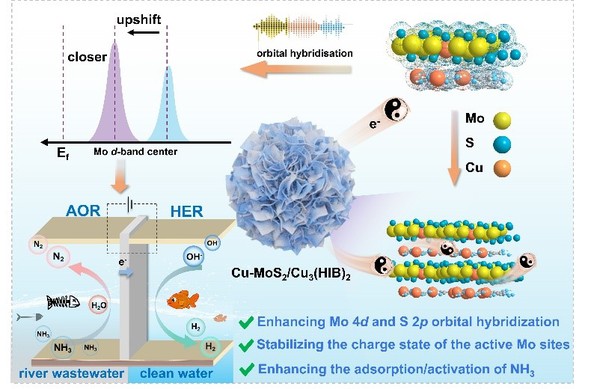| [栏目图片] |
Research Team Led by Professor Zhang Zhihong from the College of Material and Chemical Engineering Publishes Research Findings on Electrocatalytic Ammonia Oxidation in Advanced Functional Materials |
|||
|
|
|||
|
|||
|
Recently, the research team led by Professor Zhang Zhihongfrom the College of Material and Chemical Engineering published their latest research findings in Advanced Functional Materials (Chinese Academy of Sciences Q1 TOP journal, IF = 19.0), a top-tier journal in the materials field. The paper is entitled "Interfacial Electronic Engineering of the 2D/2D Cu-MoS₂/Cu₃(HIB)₂ Heterojunction for Bifunctional Ammonia Electrolysis: Synergistic Hydrogen Production and Wastewater Detoxification."Dr. Liu Jiameng and Dr. Zhang Shuai from the College of Material and Chemical Engineering serve as co-first authors, master's degree candidate A Yulong as student first author, and Professor Zhang Zhihong and Professor Du Miao as corresponding authors. Zhengzhou University of Light Industry is credited as the sole affiliated institution for this work. As an important chemical raw material, ammonia is widely used in the pharmaceutical, food, and agricultural sectors, representing a potential hydrogen carrier. However, it is easily discharged with wastewater and poses hazards to both the environment and human healthdue to its high water solubility. The electrocatalytic ammonia oxidation reaction (eAOR) is a crucial removal method that can not only convert ammonia into non-polluting nitrogen gas and water but also replace the oxygen evolution reaction(OER) which suffers from high overpotential and sluggish kinetics. When combined with the hydrogen evolution reaction(HER), it accelerates hydrogen production, offering both environmental and energy benefits.To address the challenges faced by electrocatalytic ammonia oxidation, the team employed the interfacial electronic engineering to develop a novel 2D/2D Cu-MoS₂/Cu₃(HIB)₂ heterojunction electrocatalyst. This catalystcould significantlypromote electron transfer and modulate active site reactivity, exhibiting highly efficient eAOR and HER performance. The assembled electrolysis device achieved approximately 100% ammonia removal rate at a voltage of 1.60 V versus the reversible hydrogen electrode, with a hydrogen production rate of 15.3 mL/h, providing a sustainable pathway for simultaneously achieving wastewater treatment and green hydrogen production. This research was supported by the Zhongyuan Leading Talent Program (Sci-tech Innovation) (Grant No. 254000510025), the Program for Innovative Research Team in Science and Technology in Universities of Henan Province(Grant No. 25IRTSTHN003), the Interdisciplinary Innovation Research Group Project of theNatural Science Foundationof Henan Province (Grant No. 232300421005), and the Basic Research Special Project of Key Scientific Research Projects in Higher Education Institutionsin Henan Province (Grant No. 23ZX001). Journal article link: https://doi.org/10.1002/adfm.202514112 |
|
Copyright © 2014 Zhengzhou University of Light Industry, China. All Rights Reserved. Add: No.136 Ke Xue Avenue,Zhengzhou,HenanProvince,PRC. Zip Code:450000 It is recommended that you use IE7 and above version of the browser to visit the web site. |
